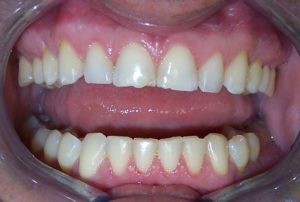How Do Teeth Change with Age?
 Just like other parts of the body, our teeth age. There are some things we can do to slow down the aging process, but we cannot stop it completely. These changes over time affect the way our teeth appear, and they also increase the risk for certain dental problems.
Just like other parts of the body, our teeth age. There are some things we can do to slow down the aging process, but we cannot stop it completely. These changes over time affect the way our teeth appear, and they also increase the risk for certain dental problems.
Internal Changes
The most notable change within teeth as they age is a thickening of the yellow, core structure of the teeth called dentin. Enamel, which is the only part of a tooth that is white, covers the exposed portion of the tooth only and not the roots. It is slightly translucent. The majority of the hard structure of a tooth is dentin, which is softer than enamel and yellow in color. There is a small hollow chamber within each tooth that contains blood vessels and nerves.
As we age, the dentin becomes thicker, and the hollow chamber becomes smaller. Because of the translucence of enamel, this thickening of dentin makes the tooth look more yellow.
Another consequence of this aging change is that there is less fluid supply to the teeth. This is because there is less blood supply in the smaller space within the teeth. This dehydration in effect makes the teeth brittle and more susceptible to cracking and breaking.
External Changes
From the outside, teeth and gums are at the mercy of the chemical and mechanical forces we put on them during eating, drinking, and bad habits.
Enamel Changes
 The enamel covering the tooth becomes thinner as a result of three different processes:
The enamel covering the tooth becomes thinner as a result of three different processes:
- Abrasion – Abrasion is the gradual wearing away of enamel by some mechanical process, like brushing with a hard-bristled toothbrush or using toothpaste that is too abrasive (like sandpaper). This thins the enamel and makes it more translucent, showing the yellow dentin more easily.
- Attrition – Attrition is the shortening of the teeth by the loss of enamel on the biting surfaces. This is typically the result of nighttime clenching and/or grinding. This makes teeth look shorter and sometimes chipped or jagged.
- Erosion – Erosion is the chemical dissolving of enamel by strong acids. This can be the result of drinking acidic beverages or suffering from severe acid reflux or chronic vomiting. Erosion also thins the enamel and can make them appear yellow. Typically, the major damage is on the inside of the teeth, so it doesn’t changes that are visible to anyone besides your dentist.
Color Changes
Teeth also accumulate external stains over time, which make the teeth appear darker. When you add this to the yellowing that accompanies internal changes, aging can cause noticeable color changes in the teeth.
Orthodontic Changes
For most people, the teeth become more crowded over time. It is a natural process for the teeth to move toward the front of the mouth. In general, this causes the front teeth to pile up on each other and look crooked.
Changes in the Gums
Many people suffer from gum recession with age. In general, we can trace gum recession to a causative factor like gum disease, teeth clenching and/or grinding, or bad positioning of the teeth. Regardless of the cause, gum recession is a noteworthy sign of aging. This is the basis of the phrase “getting long in the tooth”, because as gums retreat and expose more of the teeth roots, it gives the appearance of longer teeth.
How to Slow Down Aging of Teeth (a.k.a. How to Keep Your Teeth Looking Young)
In order to combat these changes that make your smile look “old”, you must commit to taking great care of your teeth.
Diet
To keep your teeth as young and healthy as possible, consider your diet. You should avoid very acidic beverages (like sodas and sparkling waters) and hard foods that pose the risk of chipping or cracking teeth.
Wear Your Retainers
If you ever had orthodontic treatment to correct crooked teeth, it is vital that you wear your retainers regularly. Otherwise, your teeth will naturally relapse, and then the aging process will worsen any crowding. Crooked teeth look old.
Protective Appliance
Most people clench and/or grind their teeth at some point in their lifetime. For some, it is a lifelong habit, and for others, it is more common during times of stress. Heavy forces on the teeth leads to many problems: attrition, gum recession, chipping and cracking of the teeth, etc . . . In order to protect your teeth from these problems, wear a protective appliance as recommended by Dr. Ann and Dr. Lauren. Not only does this protect your teeth and keep them looking healthy and young; it also protects expensive dental work.
Never Use Your Teeth as Tools
Teeth are meant for eating, speaking and laughing, and that’s it. Using your teeth to open packages, cut fishing online or biting fingernails puts them at a high risk for chipping and cracking.
Teeth Whitening
The only non-preventive action on this list is teeth whitening. Because we cannot prevent the internal changes that occur naturally with aging, we can’t prevent the corresponding gradual yellowing of the teeth. We can, however, counteract it by using teeth whitening products.
Professional teeth whitening is the fastest and least expensive way to give your smile a younger appearance.
More Questions about Aging Teeth?
Call Designer Smiles today to schedule a consultation with Dr. Ann and Dr. Lauren. They can answer any questions about the aging of teeth and help you take preventive or corrective action to give you the smile you want.
